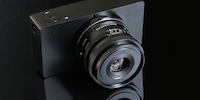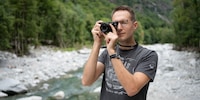

A matter of settings: testing the Pentax K-3 Mark III
The new Pentax K-3 Mark III SLR camera offers settings galore and quite solid image quality. Granted, it does have clear weaknesses. In the end, your satisfaction with this camera will depend mostly on your needs.
The Pentax K-3 Mark III is a very special camera. Firstly: it’s a Pentax. Such cameras are rare, with new releases being even more unique. This model’s predecessor dates back to 2015. Second: it’s an SLR camera. The only one released so far in 2021, all other novelties are mirrorless. Third: the sensor uses the APS-C format, which is rather neglected nowadays. Larger full-frames are all the rage these days – especially if a camera is rather expensive and ambitious.
And the Pentax K-3 Mark III is certainly ambitious. The rugged magnesium alloy body is dust and splash resistant, can be expanded with a battery grip, and has two card slots. Its integrated image stabiliser is supposed to compensate up to 5.5 f-stops. This stabiliser adds mobility to the sensor that can also be used for pixel shift and astrotracing – the tracking of star movements. The addition of a studio flash system indicates a demanding target group. Above all, the camera offers tons of features and settings.
The new Pentax is thus aimed at passionate enthusiasts longing for the charm of SLR cameras, while still wanting a modern model. It comes in black and silver.
An initial probing
The camera makes a solid, high-quality impression at first touch. This might have something to do with its weight: at 820 grams, the Pentax K-3 III weighs exactly 100 grams more than the Nikon D7500, also a solidly built APS-C SLR. Both are about the same size, with the Nikon D7500 being slightly taller. The handle on the K3 is comfortable, even for large hands.
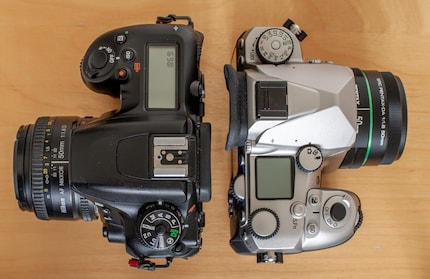
The casing has an above-average number of controls. Despite the secondary screen on the upper side, there is room for another dial – in addition to the two usual ones on the front and back. Next to the on-off switch, you’ll find the good old dim key: it displays the currently selected aperture in the viewfinder, allowing the depth of field to be estimated in advance.
Furthermore, there is a lock button to prevent accidental inputs, a RAW button, a button for the built-in image stabiliser, a mini-joystick and a green button – just to name a few.
Most of these keys and wheels can be freely configured. For example, I changed the Av mode to select the aperture on the front dial instead of the rear dial. The rear wheel is a little too far away for my thumb. I used the RAW button to manually turn the backlight for the small secondary screen on and off.
The second rear dial offers a so-called smart function. By default, it is set to switch between different autofocus configurations. For example, I can switch from AF-S to AF-C and from single-field to auto-field selection at the same time. You can define exactly how these AF presets look in the settings. However, you can also assign the rotary wheel to a completely different function.
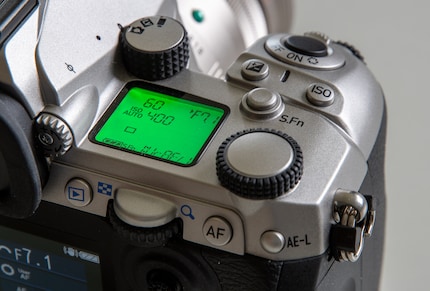
Options, options, options
Onto what makes this camera stand out: an almost absurd number of options, features and settings. I couldn’t possibly list them all. Just as an example, this camera allows you to change the colour temperature unit from Kelvin to Mired. I didn’t even know this unit of measurement existed.
The menu design can be customised in colour and style. You can combine interval shooting and multiple exposure, or let the camera make random colour adjustments. And if you like a setting, you can always save it for later.
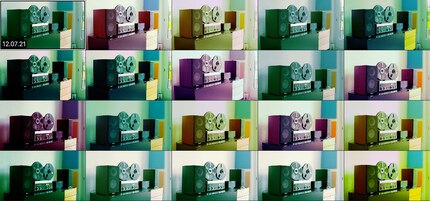
Aside from semi-useful gimmicks, there are also options that I find quite practical. This includes the ability to save files with high colour depth in Pentax raw format as well as DNG (Digital Negative Format). I did this immediately, of course. As with almost every new camera, the RAW converter cannot read the files. DNG, on the other hand, is a uniform standard and always works.
Aside from the usual four shooting modes (P, A(v), S or Tv and M), Pentax also has Sv for ISO preselection. In this mode, a fixed ISO value is selected while the aperture and shutter speed adjust automatically. TAv does the reverse; here the ISO adjusts while the aperture and shutter speed are fixed. Manual mode basically works without automatic ISO. In addition, there’s also B mode for long exposure and X for flash synchronisation. Then there’s «Hyper mode»: with this, you can also set the aperture or shutter speed in P mode. Depending on the setting, the camera then switches to a different mode until you press the green button, or it adjusts the rest automatically.
Pentax overdoes the options a bit here. With other brands, operating modes are structured much more simply, without missing anything important.
Given this many options, I’d definitely create user presets. Fortunately, the camera is strong in this aspect too. Five different user modes can be selected directly on the dial, and another five in the menu. In these user modes, you can save almost everything related to image capture. This is important, as with such abundant settings, you’ll definitely need good presets. Otherwise you’ll spend a day configuring instead of shooting. Another important and commendable titbit: the factory settings are good. You don’t need to optimise the whole camera first before you can get started. This, too, deserves high praise. Otherwise, Pentax would’ve dumped finding a good operating concept onto the users.
With this camera, you can set which of the current settings should be retained when the camera is turned off and which should not. The only thing I’d wish for with so many options would be the ability to save presets to the SD card. This doesn’t seem to be possible.
Here’s a quick tour of the menus.
Viewfinder and screen
The screen is large (3.2 inches), high-resolution (1.6 MPx) and touch-sensitive. It is, however, locked in place. In my opinion, it’s this camera’s biggest weakness. Shooting near the ground is tedious, overheads are only possible without vision, and you can forget about self-control when recording videos.
On the other hand, I can’t complain about the viewfinder. It offers 100 per cent coverage and 1.05x magnification – reliable values. The viewfinder is large and bright. There’s a comprehensive info area at the bottom. Grids can be superimposed in the viewfinder itself, and best of all: a spirit level shows if you’re holding the camera straight. The aforementioned dimmer switch helps make the viewfinder a real joy to use.
However, it’s also a good example of Pentax’s options excess: you can change the aperture preview from optical to electronic in the settings. An electronic preview in a non-electronic viewfinder? How is that supposed to work? Not at all. The camera takes a photo and displays it on the screen. It’s only called preview because the image is saved to the card after your confirmation.

A small auxiliary LCD on the top of the camera displays the most important shooting parameters. It can be illuminated automatically or manually. Without illumination, such screens require virtually no power, which is why they’re always on in many cameras. Not with the Pentax. Even in power-saver mode, the information disappears.
Lenses
Lenses for the smaller sensor as well as those for the full-frame can be connected to a Pentax APS-C camera. I use this full-frame 31 mm lens, which provides a standard crop on APS-C. It visually matches the silver variant of the K-3-III very well and delivers a nice bokeh.
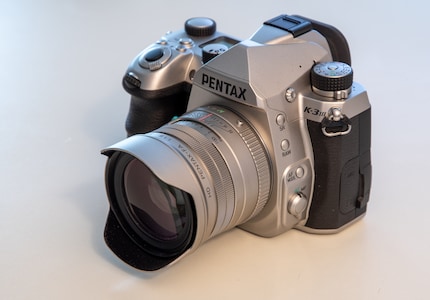
The second lens I used in my test was a budget 50 mm lens. The crop corresponds to 75 mm in a full-frame format, so it’s suitable for portraits, and the open f/1.8 aperture is also large enough for that. However, it isn’t particularly sharp with an open aperture.
Both lenses use outdated autofocus technology. This is mainly noticeable by an unpleasant and loud focus noise. When using these lenses, videos should only be made with manual focus.
There are modern lenses with quiet focus motors, recognisable by the abbreviation SDM in their name. Such as this one here. Unfortunately, it wasn’t available for a very long time, which seems to be a general problem with this brand. I simply ordered the lenses that were available at the time.
Image quality
For an APS-C camera, the images only display minimal noise, even in the high ISO range. You can go up to 1,600,000 ISO. This makes no sense – the quality is subterranean, and you’ll never need it. But the subject is already clearly visible at 102,400 ISO at least, and I consider 12,800 ISO absolutely usable. Together with the built-in image stabiliser, the camera is ideally suited for hand-held nighttime snapshots. Even though the image stabiliser compensates 3 to 4 exposure stops rather than the 5.5 stops stated by the manufacturer.
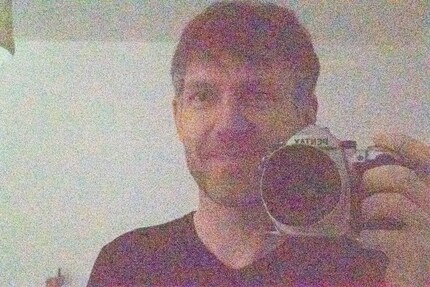
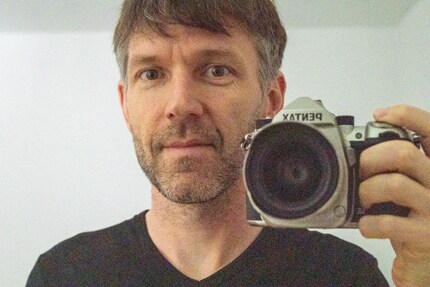
A special feature on this camera: noise reduction, sharpness and other settings that affect image quality don’t just apply to JPEG, but RAW/DNG as well. This does mean that «RAW format» is no longer really raw, but that’s irrelevant. If you find that the camera doesn’t do noise reduction or sharpening well, you can disable it. You can even set noise reduction differently for each individual ISO value.
As far as dynamics are concerned, this being the ability to reproduce bright and dark areas equally finely: I’m happy to leave the lab tests to others, but I’m absolutely satisfied with the performance in normal use. Here’s an extreme example: facing the sun in the evening, the image has harsh contrasts. These can be compensated very well in the RAW editor without causing excessive image noise.
RAW image without corrections:
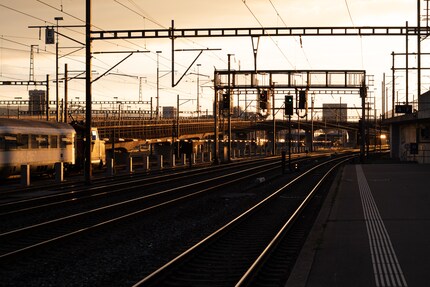
With brightness and depths corrected to the max (Adobe Lightroom):

Magnified to evaluate the image noise:
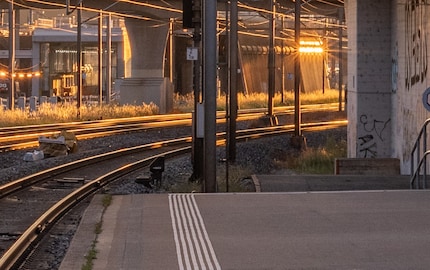
Scintillating speed for action shots
According to its spec sheet, the camera offers 12 frames per second. That’s a solid value, suitable for action. The buffer memory can store around 40 DNG images – 35 if JPEGs are also saved at the same time. That’s okay, too. However, the buffer memory empties quite slowly, even with a fast SD card. You therefore can’t record longer high-speed series in quick succession.
I couldn’t realistically test whether the autofocus is fast and accurate enough for sports or other action, since I lacked the appropriate lenses. However, facial recognition barely even worked reliably at a party where people moved at a snail’s pace – so I have my doubts. On the positive side: the AF points cover almost the entire width of the viewfinder, which is helpful for subject tracking. The camera offers scene detection, but it isn’t specified in much detail. Uncharacteristically for today’s model, this setting cannot be configured.
Video
I was disappointed by video mode. The camera has connections for headphones and an external microphone. It can record in «4K» (UHD) and Full HD. 4K is only possible at 24p and 30p, Full HD gets up to 60p. 25p and 50p are absent, as are slow-motion recordings. With 4K, you don’t have the full frame available, the image is cropped significantly. The camera also turns itself off when it overheats. This usually happens after eight minutes at best given normal room temperature and the highest quality settings.
A red light is integrated in the handle. This could signal people in front of the camera that a recording is in progress. But strangely, this light flashes when no recording is in progress. And while you can customise pretty much everything else about this camera to your liking, you can’t change that.
The battery also only lasts for a very short time in video mode.
Connectivity
Ricoh provides the «Image Sync» app for smartphones. Connecting it to the camera works reliably. I can see the camera’s viewfinder image on my smartphone and control it remotely. Focus, the aperture and all other shot parameters can be set in this way. The «Synchronize date & time» function is quite practical: it sets your camera’s clock according to the smartphone. Synchronising the camera with mobile communications and displaying time accurately.
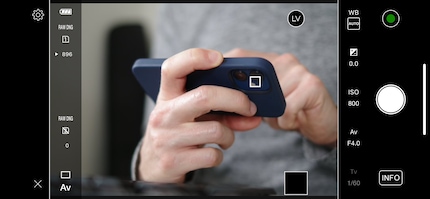
Images should theoretically be able to be transferred to your smartphone in reduced or full resolution. However, it only worked in reduced resolution for me. I still don’t know why. There was no error message, the app just did nothing when I pressed the download button. Should we expect an update soon?
My verdict
The Pentax K-3 Mark III is a device for lovers of classic, high-quality SLR cameras. It certainly meets the requirements set by this target group. This camera’s strengths are typical for SLRs: robustness, solid image quality and complex but well thought-out operation. The same applies to its weaknesses: Live View and video functions don’t remotely come close to a mirrorless camera in the same price segment. In addition, there are isolated negative points that aren’t exclusive to an SLR. The immobile screen. Its slow writing speed. The mediocre battery life and the fact that no external charger is included.
But in the end, the most striking thing about this camera is clearly its countless settings. They surpass anything I’ve ever seen, even in professional cameras, and Pentax sometimes borders on the absurd. Even if it doesn’t really provide any added value: the incredible range of options shows a lot of attention to detail, and I feel taken seriously as a photographer. Moreover, the factory settings are useful, so you can get started without a long setup.
Bottom line: certainly not a camera for everyone, but a solid device if you like SLR cameras.
My interest in IT and writing landed me in tech journalism early on (2000). I want to know how we can use technology without being used. Outside of the office, I’m a keen musician who makes up for lacking talent with excessive enthusiasm.

